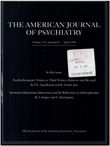Childhood sexual, physical, and psychological abuse in bulimia nervosa
Abstract
OBJECTIVE: This study sought to determine if rates of childhood sexual, physical, psychological, and multiple abuse (i.e., abuse in more than one form) differed between women with a lifetime history of bulimia nervosa and women with no history of eating disorders. METHOD: Subjects were 80 women, aged 18-35, with a lifetime history of bulimia nervosa (40 women who had recovered for a year or more and 40 women currently suffering from bulimia nervosa) and 40 women who had never had an eating disorder or related difficulties. The cohort was obtained primarily by newspaper advertisement. Subjects participated in structured diagnostic interviews and completed paper-and-pencil questionnaires related to abusive experiences in childhood. RESULTS: Women in the bulimia nervosa group reported higher levels of childhood physical, psychological, and multiple abuse. Contrary to expectation, rates of sexual abuse did not distinguish the groups, except in combination with other forms of abuse. CONCLUSIONS: The higher rates of psychological, physical, and multiple abuse found among women with a lifetime history of bulimia nervosa than among comparison subjects underscore the importance of examining the full range of possible abusive experiences in women with eating disorders, rather than focusing simply on sexual abuse.
Access content
To read the fulltext, please use one of the options below to sign in or purchase access.- Personal login
- Institutional Login
- Sign in via OpenAthens
- Register for access
-
Please login/register if you wish to pair your device and check access availability.
Not a subscriber?
PsychiatryOnline subscription options offer access to the DSM-5 library, books, journals, CME, and patient resources. This all-in-one virtual library provides psychiatrists and mental health professionals with key resources for diagnosis, treatment, research, and professional development.
Need more help? PsychiatryOnline Customer Service may be reached by emailing [email protected] or by calling 800-368-5777 (in the U.S.) or 703-907-7322 (outside the U.S.).



